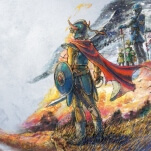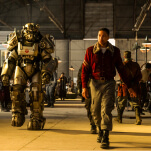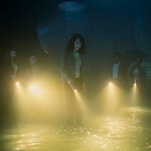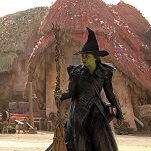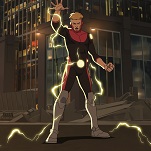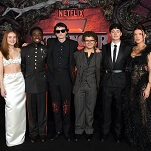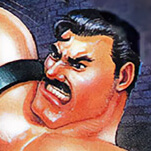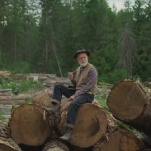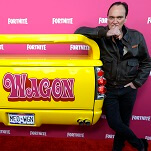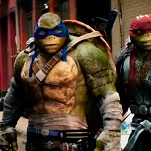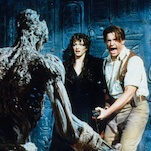It’s not 20 minutes into playing Dragon Quest I & II HD-2D that I text my mom a 30 second clip of my descendant of Erdrick fighting a Slime. It’s the most primal distillation of Dragon Quest. My guy—named “My Guy” so that everyone will address this generational hero as “My Guy”—is just hacking away at a grinning, gelatinous, cyan Hershey’s Kiss. The Tokyo Metropolitan Symphony Orchestra’s bellowing out the battle theme, an update on the more-alarming-than-epic original from the Ricoh 2A03, but still disruptive, palpating, driven—the ruinous antithesis of harmony. I add to the video clip the message “35 years later, I’m back here again…” At first she didn’t remember. Then I find the equivalent clip from the NES original, and it all comes back to her.
“I like the old version better,” Mom replies.
The old version, Dragon Warrior, was first played when I was barely older than six. In the finished basement with high pile garnet carpet (which, after I spilled an entire bottle of India ink on a 2×2′ section of it, I am told, was very expensive and en vogue). Subterranean brick walls from before the Civil War were lined with my stepfather’s first editions. While radon secretly pooled for the first several years we lived there, camel crickets routinely invaded. The light switch was at the bottom of the stairs a foot or so into the cavernous space, which made descending into the depths not entirely unlike a dungeon itself, filled with nightmares. It’s down here where I would spread Rubbermaid containers full of LEGO out like trapped floors for my parents. Where I would lay motionlessly on the floor watching Labyrinth and Legend on well-worn VHS tapes while our golden retriever was my sole companion during horrible bouts of strep throat. And, of course, this is where the Nintendo lived for its entire lifespan.
Plugged into an RCA console television the size of three 7-year-olds standing in front of it, flanked by JBL loudspeakers and a mixed set of German and Japanese hi-fi components, the view port into the world of Dragon Warrior was a Colossus of glass and real wood cabinetry. A black plastic and metal strip of slim buttons ran across the top, giving it a futuristic feel compared to the clunky knobs of the kitchen TV that required me to learn the difference between VHF and UHF. It was huge, and the monitor almost begged you to put your tongue to the glass, to taste the phosphor dots that coated the inside where electrons collided and the curvature of the vacuum sizzled with static pops if you walked by too closely. This is where the Challenger exploded. Where Dukakis catastrophically lost. Where MTV shifted from Nina Blackwood to Julie Brown. This beast that defied the workings of the cosmos, even as it was bound and animated by them, was where I first unknowingly watched anime. And, as it happens, it was on this Promethean marvel that I first defeated the Dragonlord.
When I thought I’d be playing Dragon Quest in my forties, I never suspected I’d be playing a remake. Me, the girl who is constantly in opposition to remakes, at least the thoughtless, maximalist Unreal Engine way that so many AAA remakes are deployed. I certainly didn’t expect it to be remade, slapped with a miserable marketing label like “HD-2D” (whatever that actually means), and bundled with Dragon Quest II as the 2nd and 3rd entries in a “new” trilogy that now “begins” with Dragon Quest III. I figured, if anything, I would be loading up the Game Boy Color port on my custom translucent teal and magenta GBC. That’s where “Unknown World” would plunk away more or less as I remembered it on the 4-channel APU through cheap headphones at night, grinding away on Slimes, Red Slimes, Drakees, and maybe (with luck and patience, but mostly luck) a Ghost. A little questing diversion before bed. Sure, it would be different from what I grew up with, but we’re not chasing pure nostalgia here—just something ever-so-slightly alongside it. But no.
This is how I ended up owning Dragon Quest I & II HD-2D: completely out of the blue, I saw a trailer, and I heard it: that overture. The bright bursting of the Tokyo Metropolitan Symphony Orchestra’s French Horn section. I sang along, in my head at first, a melody of ba-da-bums, then as loud as adults are allowed to sing where other adults might hear them. Koichi Sugiyama was a war crime denying, homophobic, nationalist nightmare, and that’s me being gentle purely for brevity. But now he’s fucking worm food, and they made an entire Dragon Quest movie that’s about how “When you hear the Dragon Quest Overture you pop so hard every part of your soul becomes an enthusiastic toddler again, especially if you’re a sad 40-something.” Life is full of unresolvable contradictions. We do our best to reconcile the monsters who left indelible marks on our minds.
It turns out that despite it being a miserable marketing tag, HD-2D does work on me. The absurd combination of lighting effects coupled with spectral dust motes, an outlandish amount of bloom, the weird parallax-like effect of retro 2D sprites and RPG Maker Asset Pack aesthetics on a 3D plane that give everything a delightful ViewMaster via snow globe via YouTube Snail Terrarium Builder feeling. Sure, Fantasian gave us real dioramas. But this feels more appropriate. There’s a tacky maximalism that brings Alefgard to life in the same way that Ridley Scott required an ecological disaster amount of natural gas, glitter, and chicken feathers to create Legend.
I’m not even a full half-hour into the game when I’m beasting my way through Erdrick’s Cave, a cave that normally required time spent learning mechanics and grinding enough to buy Leather Armor and a Club to upgrade from the Bamboo Pole and Clothes, learning HEAL and HURT to handle those miserable Ghosts in North Alefgard. Turns out in re-imagining Dragon Warrior into Dragon Quest I HD-2D, Tantegel Castle consumed the town of Brecconary (which I once considered a second home) and obliterated the need to grind for weapons, boosting the hero of legend several tiers above the original starting point with a Copper Sword. No wonder I was mowing my way from Tantegel Castle to Galenholm (it’s Garinham, damn it) without stopping to rest once despite being on the hardest difficulty setting.
And would you believe it? Not only have monsters taken over Erdrick’s Cave (they’re all pushovers in this version so they might as well not be here), you don’t even need torches anymore. Not having a torch in Dragon Warrior was one of the first moments of real anxiety I experienced playing video games. Jumping through Bowser’s flame pinwheels was nothing in comparison to trekking across the grasslands, foothills, and forests of North Alefgard to this cave only to realize that caves in Dragon Warrior require torches to navigate, to fight in, to survive. This is the developers teaching the rudiments of dungoneering to a population who had only recently gotten an official release of Dungeons & Dragons. Now, torches never ran out in the original game, unless you left the dungeon, but the game doesn’t tell you this. The manual doesn’t mention it. I don’t even think the Nintendo Power Strategy Guide offers up that information within its pages of moody Katsuya Terada illustrations. And even though later Dragon Quests would remove the torch mechanic entirely, it’s absence gestured at by my little blue-armored adventurer raising a non-systematized torch above his head whenever things get dark, feels as weird to me as the laundry list of skills I picked up on my way to level 8 (an absurd level to hit before crossing the first continental bridge).
“Would your niece like Dragon Quest?” My mom texted back.
I don’t have an answer for her at the time. But part of me did pick this new version up with the thought that maybe my niece is ready for her first real RPG. Is this something I could hand down to the next generation of gamers in the family? Despite my mother betraying me and buying a PS2 out from under me from my then-boss’ brother and her IT director (“it just seemed fun to have”), my sister never took to gaming. But it turns out that my niece really liked Pole Position. Has a habit of disappearing into the cleaner, brighter contemporary arcades during trips to the shore or malls. I hear she mains Cassie Kage in Mortal Kombat, and fell off Animal Crossing: New Horizons for the same reasons I did. As I understand it, she’s so far been kept away from Fortnite and Roblox. Her dad’s a gamer—not a gaming professional like her derelict aunt, mind you, but enough of a gamer that he seems to have prevented her from going down that dark path. But is Dragon Quest I HD-2D suitable for her? It’s the question that I carried with me through the next 15 hours of this sprawling, fast-paced, weirdly scaled, and story-laden version.
Almost everything that was rough around the edges in Dragon Warrior has been filed smooth. Most glaringly here are quest reminders and quest markers to guide players directly to the next location. Modern affectations known as “quality of life improvements.” No longer do player-adventurers need to orient themselves on maps or worry about choosing the wrong fork around impassable mountains (wasting time, resources, and maybe their lives), they don’t even need to keep track of what NPCs have told them; in Dragon Quest HD-2D, whole conversations can be buffered and saved for later review. There’s no need to keep a notebook of secrets and progress. The game will do all that for you. That’s what Quality of Life means here: shit you don’t need to pay attention to anymore. But if so much of Dragon Quest‘s real story is, as sraëka lillian writes, “here on its world map, in the small-scale stories of survival on the expanse, and in the larger-scale stories of evolving relationships to space,” what are we actually improving upon here?
When I think about my niece, I marvel at how the contemporary gaming child is so much more sophisticated than I was at their age. Their gaming vocabulary and the depth of mechanical understanding feels so categorically different. They have more buttons, more bits, they have a whole third dimension. But most importantly, their games are everywhere, perpetually—not just tethered to a television set they have to share with Crossfire and 60 Minutes. They are inundated with not only gaming but gamification. My niece has already become bored with the complexities of Stardew Valley; she understands RPG mechanics on an intuitive level, without even knowing what an RPG is.
I’ll admit, I’m intimidated by trying to decide if a game is right for my niece or not. I’m intimidated by trying to pin down contemporary games in any kind of generalized way where I can say who Dragon Quest I & II HD-2D is even for. It’s more systems heavy than the Dragon Warrior that came before, but so little of that has anywhere near the impact of knowing the relationship between Strength/Agility vs Defense Power in the original game. It’s graphically intense by comparison, but in a lower-powered, more affordable way than a AAA flagship release, and its symphonic score turns a chiptune charmer into an orchestral delight. But most of what it’s doing is simply building out from the limitations of the original cartridge. The first two-thirds of Dragon Quest is now a breeze, and then walls start shooting up from the ground as enemy scaling and capability. One descendant of Erdrick is simply going to get numerically stymied by multiple enemies that get to take multiple turns because they can lock the player out of taking actions. Whereas Dragon Warrior was a game about brutal Beowulfian tussles, a large portion of the later continents are simply about getting dogpiled by wolfmen—which the game doesn’t teach you how to handle the way the original version does.
And so I return to the question, “Would your niece like Dragon Quest?” And I try putting it another way: Would I like my niece to like Dragon Quest? Of course. For me, Dragon Warrior came first. Before the Tavern/Dungeon loop of Wizardry and the tedious expansiveness of Ultima, before Bard’s Tale, before the longitudinal Frieren-like party management of Sorcerian and the deep fixation with Phantasy Star, before even tabletop… there was Dragon Warrior. And it was overwhelming. If the manga about the foundation of Enix is to be believed, and I see no reason to cling to an inflexible factuality over embracing the whimsy of corporate hagiography (at least in this instance), Yuji Horii throws himself into Wizardry after an Enix-sponsored trip to the 1983 Applefest in San Francisco. This irrepressible enthusiasm is what then whipped him and Koichi Nakamura into a frenzy to eventually create Dragon Quest. And then Dragon Quest would set off a chain reaction that would touch the lives of every single gamer from 1986 onward whether they liked it or not, or even with their knowledge. I was one of those gamers. Dragon Quest—renamed Dragon Warrior in America, of course—was my gateway drug to their gateway drugs. The smoothed over Wizardy edges and simplification of Ultima sucked me in, along with those delightful Toriyama enemy designs. A complete encompassing of the joyous spirit of adventure in 8-bits. Who wouldn’t want to pass on the elation of experience like that?
The difference is, when I was young, games were also young. Dragon Quest was the game designed to communicate games like Wizardry to a wider audience—the My First Sony of RPGs. We grew up together as much as I grew up with games. You can’t hand a modern child a vintage console and say “prepare to have your mind blown.” Nine times out of 10 it will fail, unless you’re a weirdo retro-gamer who has raised your own weirdo retro-gamer kids. I know, I sat there with my sister and my hand-me-down NES and she looked at me like I was the biggest asshole in the world as I explained Castlevania. This isn’t like the time my own aunt slapped a cassette of Black Sabbath’s second album into my hand at 12 with a wink and a toss of her dark patchouli-scented hair. Heavy metal, it turns out, is a bit more transcendent of time than video games.
But I wonder if those kinds of experiences are even as potentially possible. There were less games, less often, less everywhere. The amount of time I spent on a game 30 years ago is substantially different from the amount of time I spend on games now, even as a voracious gamer with fairly permissive parents between rentals and purchases. A game like Dragon Warrior could sink into your marrow simply because there was nothing else like it in your world, games were still too new and rare. They became weird obsessive objective correlatives of our youth. Which is probably a significant component of why our whole generation simply cannot be normal about them (present company included). Don’t believe me? Just try telling a group of 30-50 year olds that Chrono Trigger isn’t the end all be all of RPGs. It’ll be like landing a sucking axe wound to a generation’s ego. Maybe my niece can just enjoy getting a video game for Christmas from her aunt who never worked for Nintendo without it changing her life.

